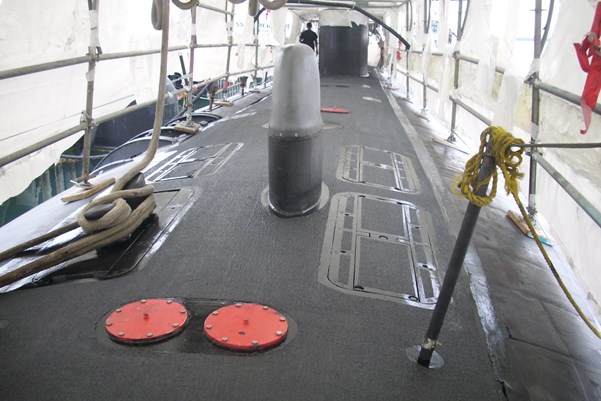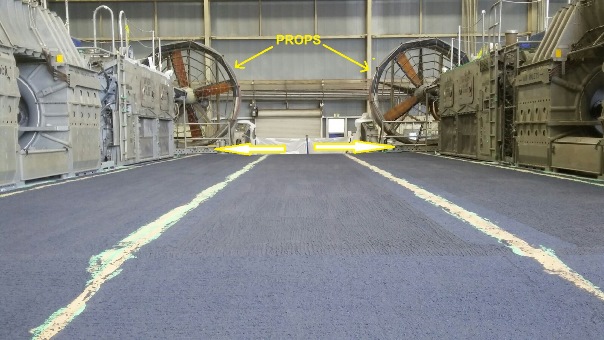Anti-slip deck coatings or the Navy’s terminology, “non-skid coatings,” are constantly undergoing testing by Navy Research Labs (NRL) and the Navy’s Sea Systems Command (NAVSEA) 05 departments with constant input and changes to standard items.
When working for military coating contracts, contractors must adhere to NAVSEA standard items, which are under review annually by the Specification Ship Repair Alteration Committee (SSRAC). This committee meets and reviews the previous year’s standard items, which cover every aspect of ship building, including non-skid coatings. Non-skid coatings fall under 009-32 standard items, where the SSRAC identifies what works and what doesn’t and how to improve the coatings application process on military vessels.
Non-skid coatings are frequently under scrutiny due to the critical service they provide for the Navy. The most critical structure where non-skid coatings are applied to is on Navy flight decks. This class of coating must meet multiple criteria depending on the class of ship and type of aircraft landing on its surface.
New Products
The Navy is always coming up with faster, better, and more capable aircraft to aid in the fight against global terrorism and defend the United States. With this new generation of updated aircraft putting out high heat signatures during takeoffs and landings, the non-skid coatings must be capable of adjusting to these high demands.
It was found that traditional non-skid coating was cracking due to the deck buckling under prolonged heat signatures, which range from 300° F to 400° F (148.9‒204.4° C). This cracking non-skid coating may cause FOD (foreign object damage) to the aircraft, which can put them and Navy personnel at risk. This is especially true on landing helicopter deck (LHD) and landing helicopter assault (LHA) class ships.
To accommodate these changes, NRL has gone through rigorous testing of a new anti-skid sacrificial coating identified as thermal sprayed non-skid (TSN), which can withstand high heat signatures. This new coating has been applied to two ships, the USS Wasp and the USS America, and NRL is currently in the process of applying it on the USS Essex.
Non-skid coatings on aircraft carriers must meet different criteria than that of LHD or LHA class ships dealing with high heat signatures. The aircraft carriers (nuclear propulsion), called CVN carriers, deal with landings known as traps. These traps work by arresting gear cables. Due to the design of these arresting gear cables, the non-skid coatings in the landing area must be non-abrasive (where the aggregate must not be hard or as dense on the Rockwell-C scale.) This non-abrasive aggregate must be capable of breaking down or yielding to the arresting gear cables, as the tail hooks catch upon hitting the deck, causing the cables to slap against this non-abrasive non-skid coating.
Normally, the aggregate used with CVN carriers is aluminum, which is a softer alloy that’s used as the non-abrasive. This is identified as Limited (L) non-skid versus the General (G) non-skid, which uses aluminum oxide aggregate and is much harder and denser on the Rockwell-C scale.
Non-skid coatings must also be able to meet the Navy’s intense travels through different parts of the world, going from cold climates to warm, and they must be durable enough to take impact from military ballistic shell casings. Some applications, such as on Vertical Launch Systems, require Low Solar Absorption (LSA) non-skid coatings. Non-skid coatings also venture to extremely cold temperatures in the depths of the ocean as deep as 490 m (1,600 ft.).
On submarines, non-skid coatings must be highly anti corrosive due to the environment and they provide an anti-slip surface for sailors when working topside. These types of non-skid coatings will have a high solvent content. The peaks of the aggregate are more rounded and not as aggressive as other non-skids aiding in less drag on the submarine as it cuts through the seas.

On Mine Counter Measure (MCM) class ships, there are flexible membrane non-skid coatings that are applied. In the military, these ships are known as mine sweepers. The entire structure is made of wood and fibrous glass, called glass-reinforced plastic (GRP). They receive a rubber membrane that’s applied to the GRP, then the flexible type non-skid coating is applied over the rubber membrane.
This same system has been introduced to Landing Craft Air Cushion (L-CAC) Hovercraft. These types of craft are solely comprised of aluminum alloy, which make them lightweight. The non-skid coatings crack and fail on the aft section of this class of ship in front of the props due to the intense vibration during operations. A new system was introduced to these locations: a type-3 flexible membrane composition. This type of non-skid coating manages to withstand the intense vibrations during L-CAC operations. This type-3 non-skid is only applied where needed on this class of ship in order to minimize added weight to the ship.
Non-skid coatings must also adapt to Environmental Protection Agency (EPA) regulations and must meet volatile organic compound (VOC) emission regulations. These regulations have implemented maximum allowable VOC content, which is the solvent based part of all coatings systems. The maximum allowable VOC is 340 grams per litter (2.8 lbs.) of VOC content. The Navy has gone to great lengths to implement higher solid coatings with less VOC content in order to stay compliant with the EPA. There are exceptions to these requirements with the application of non-skid color topping coatings. Color topping coatings are applied for Visual Landing Aids (VLA). These deck markings are applied on top of the non-skid coatings for flight operations guidance. Color topping coatings must be thin in nature in order not to degrade or impair the anti-slip properties of the non-skid coatings. These types of coatings are considered specialty coatings with a maximum allowable VOC content of 420 gpl (3.5 lbs.) of VOC content.
The companies that manufacture these coatings must go through extensive testing before being added to the NAVSEA Qualified Product Data (QPD) list. Prior to selecting a non-skid coating, it must be on this list and have a water mark on the manufacturer’s ASTM-718 stating that it is “NAVSEA REVIEWED”. These approved products can be found on the National Surface Treatment center’s website NST.BIZ.
The Future
Non-skid coatings are important in flight operations and ship force safety, and they will continue to be one of the Navy’s priorities.
About The Author:
Johnny M. Sanchez has 23 years of non-skid and other multiple coatings applications experience, along with corrosion assessment of different alloys and failure analysis of protective coatings. Sanchez also is a certified Society for Protective Coatings (SSPC) Lead Instructor for multiple courses. For more information, contact: Johnny Sanchez, www.sbsbtc.com
This feature is part of a special anniversary series in 2017 in which CoatingsPro is reflecting on and updating the magazine’s most-read digital stories. To see the original article, as it appears online, please click here.
